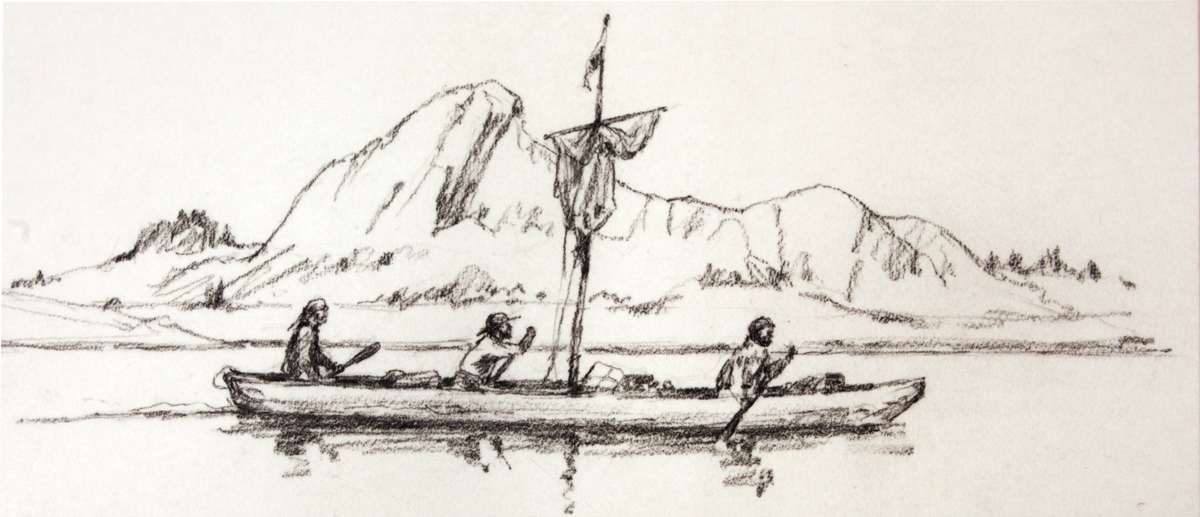Returning to the Falls of the Missouri
Photo from an interpretive sign at Tower Rock State Park near Cascade, Montana. Photo by Kristopher K. Townsend.
This Pennsylvanian has a western Idaho river and town named for him—at a location off the Lewis and Clark trail. He may have seen the river himself after the expedition, when he was on the tributary of the Snake River as a trapper in 1807, and might have described it to William Clark, who added it to his final expedition map (1814), and the name stuck.
He came from a prominent Berks County family[1]Larry E. Morris, The Fate of the Corps: What Became of the Lewis and Clark Explorers After the Expedition (New Haven: Yale University Press, 2004), 153,199. and was not, like many of his comrades, raised on the frontier. But Weiser, one of the Corps’ best rifle shots, obviously took to the rough frontier life.
Weiser transferred into the Lewis and Clark Expedition from Fort Kaskaskia in the Illinois country. He had a rocky start with the Corps, being among several men restricted to Camp Dubois for ten days in March 1804 for using “hunting or other business a pretext to cover their design of visiting a neighbouring whiskey shop.”[2]Moulton, ed., Journals, 2:179.
Clark accepted Weiser as one of eleven volunteers to go with him from Point Distress to the Pacific coast in November 1805. They traveled as far north as today’s Long Beach, Washington, without locating a viable place for the winter encampment. Clark also took Weiser in his Willamette River exploration party in 1806, and when he traveled ahead along the Columbia River to purchase horses. On the return through Montana that year, Weiser was with Clark until his assignment to Sgt. John Ordway‘s canoe party that traveled the Missouri from its headwaters to the Great Falls. (During that portage, Ordway reported on 23 July 1806 that Weiser “cut his leg with a knife So that he is unable to walk & is a bad wound,” but the injury apparently healed without infection.)
On 28 December 1805, Weiser and Willard were sent along to transport gear and help set up Salt Camp. When they did not return promptly, the captains feared them lost, but the men arrived at Fort Clatsop on January 5 safely. They reported that locating “a convenient place” took the men fifteen miles southwest of Clatsop, where Salt Camp was created near a Tillamook lodge. The returnees also delivered a welcome batch of salt, which had been missing from the Corps’ diet since December 20.
Weiser went to work for Manuel Lisa after expedition’s end, returning to Montana in 1807 to help build Fort Raymond on the Yellowstone River at the Bighorn’s mouth. He traveled alone over the winter 1807-1808 as far as western Idaho, trading and inviting Indians to the new post—and locating the river that carries his name. He stayed in Montana until 1810, when he returned to St. Louis. Weiser apparently had lent John Potts $499.50, because he sued Potts’ estate for that amount. Only two years later, though, Weiser filed for bankruptcy.[3]Morris, 153.
The last record of him shows that he served in the army again for thirty days in the spring of 1813. Clark recorded Peter Weiser as “killed” in his 1825-1828 list.[4]Ibid.
Notes
Experience the Lewis and Clark Trail
The Lewis and Clark Trail Experience—our sister site at lewisandclark.travel—connects the world to people and places on the Lewis and Clark Trail.
Discover More
- The Lewis and Clark Expedition: Day by Day by Gary E. Moulton (University of Nebraska Press, 2018). The story in prose, 14 May 1804–23 September 1806.
- The Lewis and Clark Journals: An American Epic of Discovery (abridged) by Gary E. Moulton (University of Nebraska Press, 2003). Selected journal excerpts, 14 May 1804–23 September 1806.
- The Lewis and Clark Journals. by Gary E. Moulton (University of Nebraska Press, 1983–2001). The complete story in 13 volumes.


